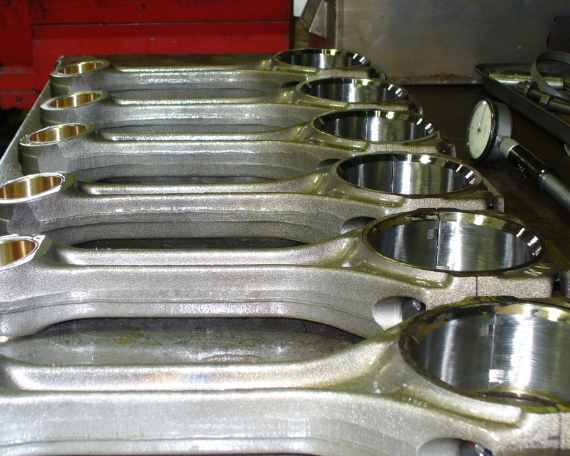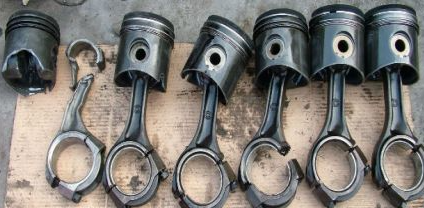Connecting rods are key components in internal combustion engines and other machinery. They transfer motion from the piston to the crankshaft and convert reciprocating motion into rotation. However, like any other mechanical component, connecting rods can fail due to various reasons, leading to potential loss of engine function. It’s crucial to understand these failures, their causes, and possible preventative measures.
1. Fatigue Failure
Fatigue failure is the most common type of connecting rod failure. It is a progressive structural damage that occurs when a material is subjected to cyclic loading. Over time, small cracks may begin to form at the surface of the connecting rod, especially in areas of high stress concentration. These cracks can gradually grow and eventually lead to a catastrophic failure of the connecting rod, potentially damaging the engine severely.
2. Bending and Buckling Failure
Connecting rods can also experience bending or buckling failure. This usually happens when the engine is subjected to excessively high loads. In such cases, the connecting rod can deform or even break due to the high forces involved. This kind of failure often results in a sudden and catastrophic loss of engine power.
3. Material Defects
Material defects are another significant cause of connecting rod failure. Any imperfections in the material from which the connecting rod is made can introduce weak points in the rod. These weak points can cause the rod to fail under loads that would otherwise be perfectly safe. Typical material defects can include inclusions, porosities, or micro-cracks.
4. Manufacturing Errors
Sometimes, connecting rods fail due to errors made during their manufacture. This could be anything from an improper heat treatment process, leading to a weaker connecting rod, to an incorrect machining process, resulting in a rod with incorrect dimensions or uneven surfaces. These manufacturing errors can significantly reduce the service life of the connecting rod and increase the chances of failure.
5. Insufficient Lubrication
Lastly, insufficient lubrication can lead to connecting rod failure. Without proper lubrication, the rod and its bearings can experience increased friction. This, in turn, can lead to excessive heat and wear, eventually causing the connecting rod to fail.
Identifying the signs of connecting rod failure early can prevent catastrophic engine damage. These signs might include abnormal noises, decreased engine performance, or oil leaks. Regular maintenance, proper engine operation, and quality control during manufacturing can help prevent these failures and extend the lifespan of connecting rods.
Contents
- Fatigue Failure
- Bending and Buckling Failure
- Material Defects
- Manufacturing Errors
- Insufficient Lubrication
- Prevention and Maintenance
1. Fatigue Failure
Fatigue failure is the most common type of connecting rod failure. It is a progressive structural damage that occurs when a material is subjected to cyclic loading. Over time, small cracks may begin to form at the surface of the connecting rod, especially in areas of high stress concentration. These cracks can gradually grow and eventually lead to a catastrophic failure of the connecting rod, potentially damaging the engine severely. To mitigate fatigue failure, it’s crucial to use quality materials and adhere to specified load capacities.
2. Bending and Buckling Failure
Connecting rods can experience bending or buckling failure, typically under excessively high loads. In such cases, the connecting rod can deform or even break due to the high forces involved. This kind of failure often results in a sudden and catastrophic loss of engine power. Using high strength materials and operating within engine limits can prevent such occurrences.
3. Material Defects
Material defects introduce weak points in the connecting rod, causing it to fail under loads that would otherwise be perfectly safe. Typical material defects can include inclusions, porosities, or micro-cracks. Regular inspection and quality assurance during the manufacturing process can reduce the likelihood of material defects.
4. Manufacturing Errors
Connecting rod failure can be due to errors made during their manufacture. This could range from improper heat treatment to incorrect machining processes. These errors can reduce the service life of the connecting rod and increase the chances of failure. Ensuring adherence to manufacturing standards is vital to preventing such issues.
5. Insufficient Lubrication
Without proper lubrication, the rod and its bearings can experience increased friction, leading to excessive heat and wear, eventually causing the connecting rod to fail. Regular maintenance to ensure sufficient lubrication can extend the lifespan of the connecting rod and avoid this issue.
6. Prevention and Maintenance
Understanding these common failures and causes can aid in formulating effective preventative measures and maintenance schedules. Regular inspection, proper engine operation, and quality control during manufacturing can prevent these failures and prolong the lifespan of connecting rods.
For more information on the topic, please refer to these related articles:
